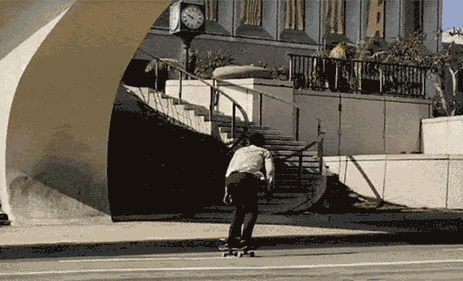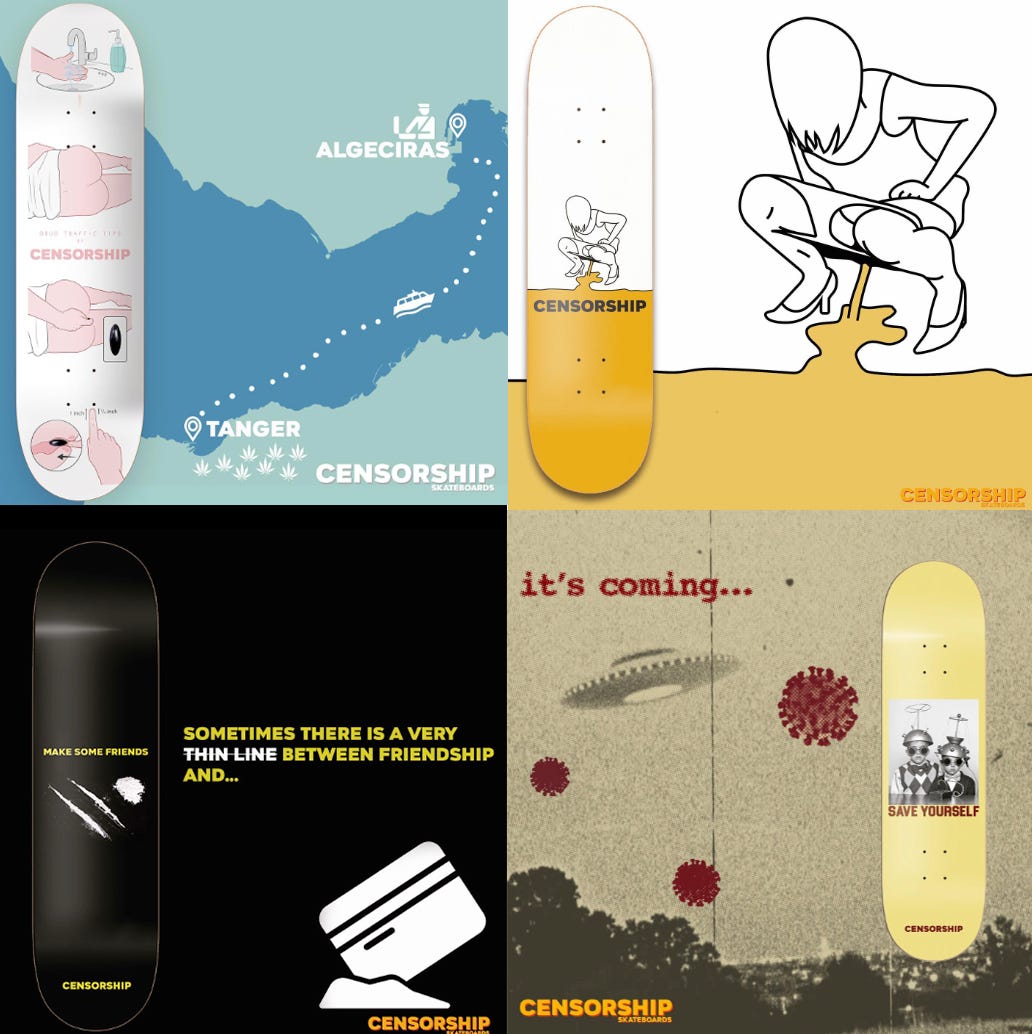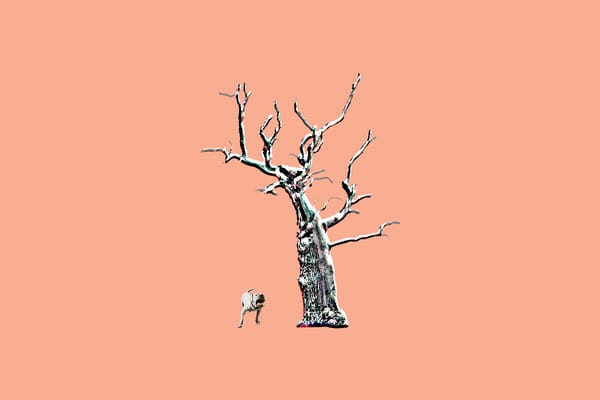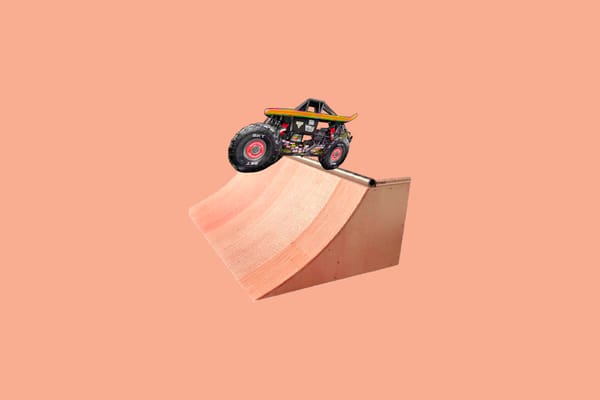Listen to me show me santa’s dogs
Plus: Greco, muddled brand identities, an existential content crisis, and more.

The definitive weekly ranking and analysis of all the skateboarding and other online things that I cannot stop consuming and how they make me feel, personally.

Hammer on the wall
Rank: 1
Mood: 🔨
Jim Greco remains firmly in his Cassavetes era, which might be the longest and most impactful form of his decades-long career. Since the release of The Way Out in 2016, Greco has put out a new “film” almost every year, creating a wholly original lane for himself within the industry. And at 44 years old, the man can still skate his ass off, evidenced by his most recent project White Wall. This offering feels more like a traditional video part than the rest of his recent oeuvre, with no apparent narrative or the gratuitous, exploitative shots of people experiencing homelessness that leaves 2020’s Glass Carousel mostly unwatchable.
While the shock of Mall Shop Greco switch frontside flipping the Wilshire 15 in Baker 3 is likely the defining trick of his career, here, his backside 360 on the steep and eponymous White Wall feels like it could have the same impact for late-stage Greco. As the final shot in the video, it’s genuinely astonishing. A crouching Greco’s left arm swings behind the back as he winds up his slight frame, soon uncorking a spin that takes him higher in the nascent transition than is understandably possible, each hand grazing the wall in separate moments of the rotation.

It’s a perfect twisting of the body. A form made beautiful through its motion. Or simply, in the parlance that Greco popularized so many years ago, it’s a hammer.

Protect me from reality
Rank: TBD
Mood: 🙈 🙉 🙊
Creating a clear, coherent brand identity can be hard. It means distilling an aesthetic and a message into something consistent yet flexible and easily recognizable across all of your products and marketing channels. And as it stretches across mediums, does that brand voice stay present and say things that make sense for it to say?
Roberto Alemañ’s Censorship Skateboards’ tagline is “Protecting You From Reality.” It’s tough to tell if that’s a satirical nod toward conspiracy culture, an embrace of it, some sort of Free Speech sentiment, or a muddled mix of them all. These things are difficult to parse in the age of moral panics around “cancel culture,” “woke-ism,” and asinine conspiracists running for and winning public office.
Aesthetically, however, the brand seems to be a straightforward extension of Consolidated Skateboards—Alemañ’s previous sponsor for over two decades—with its crude, crass illustrations and unsubtle cultural riffs.

What a woman pissing on the ground or doing cocaine has to do with censorship is unclear. Perhaps just having those images as board graphics is a strike against the perceived censorial nature of our modern world. Who knows. My read is that there isn’t a greater meaning to any of the brand’s product messaging. I’d guess that they just think this stuff is funny.
As far as their videos go, Censorship’s latest, Let Them Believe (let them believe what, one might wonder), which was released on Free this week, looks like a less-polished $lave Skateboards edit. However, the skating in Let Them Believe is, frankly, amazing. Roberto Alemañ is still hucking himself onto and off of giant obstacles in what must be his early-to-mid 40s. Dubann Machuca is an otherworldly talent who delivers a double part that needs a rewatch or two to comprehend everything in it fully.
So while their brand identity is a tortured and nebulous thing, there’s one truth that can’t be kept from the masses: the guys on Censorship are very good at skateboarding.

Listen to me show me santa’s dogs
Rank: 2
Mood: 💻🎅🐶
In 2001, when it seemed like the only place on the internet worth going to as an 11-year-old was Ebaumsworld, I also attempted—mostly unsuccessfully—to look at skateboarding online. The halting, screeching dial-up modem was much less effective than the immediacy of the phonebook-thick issues of Transworld that littered my room or the usual VHS rotation of Misled Youth and Fulfill The Dream. But I still tried, even if I didn’t have a solid grasp of how a search engine worked, typing “skateboarding” into the ether and clicking around until I found a three-minute Quicktime video that took 30 minutes to load one minute of before freezing.
I’d also plug the name of whatever I’d just seen in the magazines—“Geoff Rowley,” “Gonz Gap,” “Grind King”—into the search bar and hope for the best. There was a mild thrill to the hunt that would generally get extinguished when the phone rang and cut off my internet connection. Now the algorithm in an app on my phone gives me beautiful Nick Mathews edits, Marbie quarter pipe combos, and the occasional Mega Ramp 720 flip without even asking. Realistically, I don’t need to search at all anymore. All the skateboarding I could ever need is captured, shared, and given to me at a rapid clip. A feeding tube of content that lies complacent; what’s coming through it barely digesting before more, and more, and more comes splashing out.

Existential content crisis
Rank: 3
Mood: 🙁🙂
Content is still a word I struggle with, even as someone who makes a living as a copy and content writer. The term is now inescapable, permanently entrenched in the lexicon. It sits comfortably in the titles of products, industries, and jobs. I even struggle to describe this newsletter as anything besides content in reaction to other content. It’s a term that feels so impersonal, temporary, commodified, and almost wasteful. This isn’t to say that everything labelled content is that or bad or less than; it most certainly isn’t. Genre-defining visual art, music, film, and writing is now considered content. But no matter how great, at the pace our culture moves, any content ultimately feels like something merely meant to consume, flushed down those proverbial feeding tubes.
Perhaps I’m being dramatic. One can always look at the screens of their various devices less or, maybe, even look at them a little closer. To take the time to appreciate what’s being given to us, to try and brush off the muck of our preconceived opinions, to see if there’s anything that shines underneath. Even The Berrics, the archetypal online content farm whose entire purpose is to publish multiple daily videos of little substance to drive engagement and ad buys, has some good content days.
One of their regular video series—whose concept is simple and dangerously clickable in a YouTube suggestion bar—“How Many Tricks Can [X skater] Do In One Hour?!” recently featured Olympic Bronze Medalist Funa Nakayama.
A mainstay on the contest circuit and recognizable by her mean front crooks and yellow Shake Junt griptape, Nakayama is an incredible talent we don’t often see outside the competitive arena. Here we get to watch her try things that don’t get pulled out at Street League or the Olympics, maneuvers that might take more than a few tries.
Amongst a slew of tricks, Nakayama lands a front tail bigspin and a front tail heelflip down The Berrics’ A-frame obstacle. She front crook bigspins the flat ledge, gets bodied trying to backside overcook the big down rail, but gets back up and does it, subsequently receiving props from none other than Shecks himself. It’s a great showcase of how big Nakayama’s bag of tricks is and generally how talented she is. And we wouldn’t get to witness this display if it wasn’t for this piece of content.
Will most of the people who watched this video remember it in a week’s time? Judging by the way we consume skateboarding media, unlikely. But some will. And the takeaway will be more important than the video’s view count or its number of shares, which is that Nakayama is an amazing goddamn skateboarder.

Like the sword-man said
Rank: 1.1
Mood: ⚔️
Whether it’s forging steel into sharpened blades, writing erotic paranormal fanfiction, building model sailboats inside of large glass bottles, collecting spoons, twirling fire, taking off before dawn to stand in the bush with binoculars pointed at the sky in hopes of catching a glimpse of birds common and rare, or dedicating a significant and ongoing portion of your life to riding a skateboard around—it’s like the sword-man said, for those of us who do these things, it’s not because we can’t do anything else, it’s because we can’t do anything else.

Something to consider: Who would you give the WGS trophy to?
Good thing:
Another good thing: The Reba renaissance… ?
A good seasonal thing:
Until next week… pick up a handful of fallen leaves and throw them at your loved one in a playful manner.






